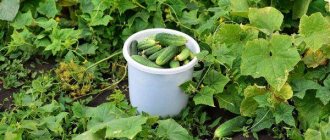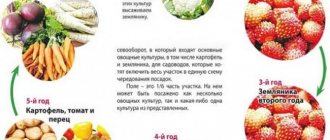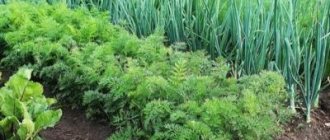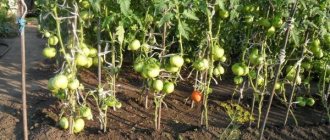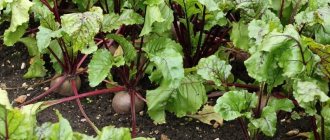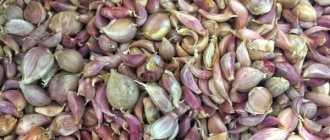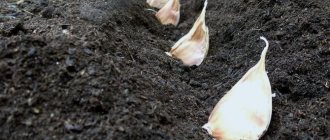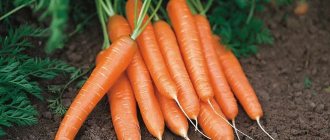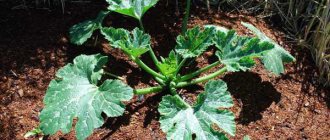Home / Vegetable garden / Bulbous
Back
Published: 12/01/2019
Reading time: 9 min
0
Are you complaining that despite careful care, the garlic harvest is getting smaller every year? Think about proper crop rotation in your garden, plan what to plant after garlic and where to place the vegetable next year. A reasonable approach will allow you to avoid excessive application of fertilizers, get a good harvest, and facilitate labor on the site.
- 1 Why is crop rotation needed?
- 2 What can you plant after garlic?
- 3 Summer plantings
- 4 Planting in the garden bed before winter
- 5 Spring sowing 5.1 Which crops are not recommended to be planted after garlic
Why is crop rotation needed?
By planting garlic in the same place every season, the gardener risks ending up with no harvest at all. The crop often gets sick, the heads become smaller, and the plantings are constantly attacked by pests. One of the reasons is non-compliance with crop rotation rules and lack of rotation of vegetables on the site.
Garlic actively takes potassium and phosphorus from the soil, which it needs for normal growth and development. The soil is becoming depleted. Without additional feeding there is no hope for good harvests. In addition, harmful microorganisms, spores of various infections, and insect larvae accumulate in the soil.
By planting a vegetable in the same garden bed, the gardener knowingly dooms the crop to diseases, mite attacks, and nematodes. That is why it is important to alternate vegetables, change plantings annually, not forgetting about the compatibility and related relationships of plants.
Benefits of proper crop rotation
Every gardener knows that it is impossible to plant the same crop every year in the bed allocated for it. The earth tends to become depleted. She needs to be given a rest. The same goes for garlic.
For your information! Growing in one place for several years, pathogenic microorganisms inherent in garlic accumulate in the ground, because of this the yield is greatly reduced. To avoid this, they observe crop rotation, that is, alternating vegetable plants in one place over the years.
Garlic harvest
Of course, it is best for these purposes to use special herbs that are capable of accumulating nutrients in the soil, but this is impossible for a garden or vegetable garden. The problem is the small cultivated area. But you can still swap cultures.
What does changing crops on land give?
In the year of planting garlic on a ridge, the soil releases accumulated nutrients to the plant for its ovary, growth and yield formation. If you do not apply fertilizers in a timely manner, then next year the soil layer will be poor. Taking these nuances into account, agronomists draw up crop rotation plans for the next 3-4 years.
What benefits come from combining garlic with other vegetables:
- schemes allow you to move the plant along the ground, without repeating planting in the same place, and also make it possible to monitor the amount of nutrients in the soil. Replacement should be carried out taking into account the consumption of nutrients by plants. In the first year - vegetables that are particularly demanding in terms of nutrition, then with a decrease in these requirements;
- By replacing garlic with another crop, the soil is disinfected, that is, subsequent plants drive away pests living on the predecessor. The same thing happens with nearby plants. For example, the garlic smell negatively affects carrot and onion flies and drives away aphids from raspberries;
- Crop rotation helps level out soil acidity.
Note! By observing rotation, the period during which plants travel throughout the entire plot, fruiting helps to achieve high yields and high-quality products. In addition, the fertile soil layer improves.
What can you plant after garlic?
Garlic varieties and species are grown in vegetable gardens, differing in the length of the growing season and biological characteristics. Winter varieties are planted in the fall (September-October, 30-40 days before the onset of cold weather), and harvested in mid-summer.
Spring varieties open the spring sowing season, and the harvest ripens by the end of August - beginning of September. The exact timing of planting and harvesting depends on the climate of the area, the characteristics of the varieties, and the correctness of agricultural technology. When planning, crops are selected for sowing in summer, autumn, and spring.
Specifics of planting vegetable crops after garlic
The secret to getting a good harvest lies mainly in preparing the soil for planting:
- Disinfection (destruction of fungi, normalization of microflora).
- Getting rid of insect pests (wireworms, nematodes, mole crickets).
- Normalization of acidity level (Ph value is individual for each crop).
- Feeding with various fertilizers in accordance with the requirements of a particular plant (organic, synthetic, chemical).
In many ways, proper crop rotation helps solve soil problems. Therefore, it is very important to know in what order to plant crops with maximum benefit for the health of the soil, and therefore the future harvest.
During growth and ripening, garlic releases phytoncides into the soil that can, to a certain extent, destroy some fungal infections. However, this bulbous crop can also suffer from diseases, which a caring gardener should help it get rid of. The main diseases and pests of garlic are:
- root rot;
- bacterial bulbous rot;
- downy mildew;
- tobacco thrips;
- onion fly.
Disease prevention involves cleaning the soil from precursor residues and treating with fungicides (antifungal agents).
Planting in summer
Having dug up winter garlic in the middle of summer, gardeners have to decide what to plant in the vacant beds. It is irrational to leave the land empty until autumn or spring, but it is quite possible to collect an excellent harvest of early ripening crops.
So, what can you sow in the summer after garlic:
- any greens (leaf and root parsley, dill, lettuce, spinach);
- radish. Summer residents often miss the opportunity to receive a delicious vitamin-rich vegetable all summer long, since they sow it only in the spring. Meanwhile, having chosen the right variety and sowed it at the end of July, the harvest is harvested within 20-30 days. The varieties “sora”, “carmen”, “dabel”, “French breakfast”, “gloriet” and others are suitable for summer sowing;
- chard (chard);
- turnip.
- early ripening cucumbers. For planting, seedlings are prepared in advance (age - 22-25 days), sprinting hybrids are selected, characterized by fast and massive yield of greens;
- Chinese cabbage (for harvesting in late autumn);
- black radish (for sowing in the first half of July), daikon. Select winter varieties suitable for storage;
- fennel;
- early ripening varieties of carrots (in the southern regions);
- green manure (oats, oilseed radish, mustard). In the fall, the plants are cut off or immediately buried in the ground when plowing or digging the area.
Select crops that require little time to ripen (30-40 days), are resistant to heat and respond normally to long daylight hours.
On a note! When sowing radishes, non-shooting varieties are selected.
Preparing the soil after planting garlic
The land is freed from garlic already in July. To plant any crop, prepare a bed.
Prepared beds for sowing next year
To do this, carry out the following agrotechnical measures:
- Soil cultivation. The soil after garlic can be infected with garlic mites, scale insects, nematodes or fusarium. These are diseases and pests specific to onions. To eliminate the larvae and spores of harmful microorganisms, the soil is thoroughly spilled with a solution of potassium permanganate or copper sulfate, having first dug up. For greater effect, insecticides are added.
- At the time of digging, organic matter is added at the rate of 7-9 kg per 1 m². Urea is used as minerals in granules, which can be easily scattered over the surface of the bed and then embedded inside.
- Garlic is often infected with powdery mildew, root and bacterial rot. To avoid this in the future, for prevention, all litter from the garden bed is destroyed and spilled with any fungicide (phytosporin, Baikal-EM, etc.).
- In the same year, you can carry out the first planting after garlic, which will increase soil fertility. These are mainly greens, for which the remaining warm time will be enough to grow. Parsley, watercress and other types of salads. If you don’t want to plant spices, then green manure will do, as it will prevent the area from becoming overgrown with weeds.
Note! If a second harvest is planned for the same year, then the bed is not treated with copper sulfate. Otherwise, you can sow after a month.
Planting in the garden before winter
Having freed the ridges from summer garlic in September, green manure is sown in this place and left in the soil until spring.
The choice of crops is huge:
- peas;
- lupine;
- Vika;
- oilseed radish;
- buckwheat;
- rye;
- oats;
- phacelia.
Nitrogen-fixing green manures include alfalfa, peas, sweet clover, and vetch. Oats, mustard, and phacelia saturate the soil with potassium. Plants help improve the health of the soil, saturate it with useful elements, and suppress the growth of weeds.
When sowing green manure in autumn (early winter), the greens are plowed into the soil. The finished biomass completely decomposes over the winter, enriching the soil with nutrients.
After what crops can garlic not be planted?
It doesn't have many unwanted predecessors. It is not recommended to plant garlic after root crops, which actively use the nutrients in the soil and quickly deplete it. After potatoes, carrots, beets and other root vegetables, the soil needs organic fertilizers and rest.
Vegetable growers also do not recommend planting garlic after spices that have pronounced aromatic properties. These are cilantro, parsley, mint, basil, coriander. Spices inhibit the development and worsen the aromatic properties of garlic.
It is not recommended to plant garlic after onions. The reasons are the same - due to the similarity of crops, the land will not have time to recover between harvests.
Spring replacement for garlic in the garden
With the onset of spring, many summer residents think about what they can plant in their former garlic beds. In the spring they will be happy to accept:
- legumes;
- potato;
- tomatoes;
- cabbage;
- cucumbers;
- annual herbs.
Not required for planting, but the recommended species after garlic are annual herbs. They help replenish mineral reserves and restore soil balance. This variety includes green peas.
Crop rotation
During planting time, beginning gardeners have to think about what to plant after garlic next year. So, there is a rule according to which the planting scheme for garden plants should change every year. This is called crop rotation, which must be followed to restore the balance of nutrients in the soil. The scheme can be drawn up in advance, several years in advance. It is important to keep track of which beds fresh manure was applied to each year. In order not to forget, it is better to mark it directly in the diagram.
To know what is planted in the garden after garlic, you need to consider that there are two types of successor plants:
- Some are planted as soon as the garlic harvest is harvested. The plot is sown with greens: lettuce, spinach or green manure if there is no need to grow new crops.
- Planting of other vegetables (potatoes, cucumbers, tomatoes, beets) can be postponed to next year.
Crop rotation rules
To maintain correct crop rotation, two rules must be followed:
- Do not use one place for growing crops belonging to the same family. For example, onions and garlic; potatoes and tomatoes; dill, cucumbers, zucchini and carrots. This is due to the accumulation of bacteria and toxins in the soil, resulting in increased plant disease.
- It is necessary to alternate between “roots” and “tops”. This way, nutrients will be used rationally, which will help maintain their balance.
Roots are the organs of a given vegetable in which nutrition is stored. They are root vegetables. The apex is the above-ground part of the plant. These are stems, leaves, fruits.
Best neighbors, what to plant next to garlic?
Garlic is good because the phytoncides and etherols it contains inhibit the development of fungal spores, so fungal diseases do not occur in those beds where garlic grows. In addition, this crop is an excellent fungicide and insecticide; harmful insects are also afraid of it. And this should be used when forming beds with crops.
Although carrots and garlic are bad predecessors for each other, if they are planted at the same time, they get along well and even help each other: for example, carrot pests such as the psyllid and carrot fly do not tolerate garlic phytoncides.
All nightshades - tomatoes, peppers, eggplants - grow better and are less damaged with such a neighbor as garlic. And if you plant potato beds around the perimeter with garlic, the Colorado potato beetle will bypass them.
Garlic also has a very good effect on strawberries, repelling pests from the berries. And not only strawberries respond well to such a neighborhood: raspberry and currant bushes will not be “populated” by aphids, ants and bugs: the garlic aroma is completely unacceptable for them.
Some advice from an experienced summer resident
Strawberries will be a worthy replacement for garlic. The plant will be strong, pests will avoid the planting site, which will guarantee healthy shoots and a rich harvest of berries.
Many summer residents follow the rules of crop rotation, but do not bother themselves with lengthy calculations thanks to the use of the following tricks. There are two ways to determine what should be planted in the place of the previous bed:
- form two beds with planting plants from different families and, when a choice comes, simply swap them;
- They use the “tops and roots” principle, that is, sequentially planting crops with the formation of root crops, replacing them with species with above-ground crop formation at the next planting.
When using the second planting rule, the principle of belonging to the same family continues to apply. For example, carrots belong to the type of roots, and dill belongs to the tops. Moreover, both plants are representatives of umbrella plants, which prohibits the possibility of sequential planting in the garden.
Garlic should not be planted after plants that require large amounts of nutrients to grow. Do not plant the plant in a place where carrots or cabbage previously grew. For planting, choose open sunny places without the problem of stagnant water. If the garden area is small, they resort to the following tricks:
- plant in the shade of trees, but plant cloves more rarely, increasing the distance between plantings;
- take advantage of the proximity to strawberries by planting planting material between the rosettes.
The key to successful cultivation and obtaining a decent harvest of garlic is the correct choice of seeds. It is recommended to adhere to the following rules:
- for planting, use only healthy cloves without signs of defects and rot;
- if there is a lesion even on one clove, the entire head must be put aside;
- Seeds older than 2 years cannot be used for planting;
- You should not use heads with a small number of cloves; such a signal indicates the degeneration of the crop.
Chaotic behavior when organizing crop rotation is unacceptable, so experts advise keeping a notebook and recording the history of plantings in it. In this case, it is worth making markings and drawing up planting schemes, including planning for future work. It is recommended to record yield indicators in order to further analyze mistakes made and successes achieved.
What else can you plant immediately after harvesting garlic?
As soon as the vegetable is dug up, green manure can be planted. These plants are not eaten. They only increase the green mass, which, after digging up the earth, serves as an organic fertilizer, thereby increasing the fertility of the soil.
Green manure plants include:
- Phacelia. This culture is considered universal. Land fertilized with phacelia is suitable for planting any vegetables and herbs. If at the end of summer you plan to place strawberries in a bed where garlic grew and phacelia has already been sown, then green manure will help the berry bush to take root more quickly and provide it with adequate nutrition
- White mustard. Green manure is good because it protects the soil from pests - wireworms and mole crickets. Mustard greens are rich in nitrogen, which will enrich the soil.
- Barley. This plant protects the soil from scab and nematodes. But it should not be planted where wireworms are found, because barley attracts this worm. In the area where green manure grew, weeds disappear.
- Oats. This green manure feeds the soil with potassium. After it, cucumbers and tomatoes produce a good harvest, root vegetables and cabbage grow well.
Crop rotation of winter garlic
These varieties are planted in the fall, even before the onset of frost. It is important not to miss the right time so that the plants have time to form a powerful root system.
- Late planting can lead to freezing of the planting material and poor future development.
- Planting garlic is also unfavorable and premature. Because the plant will begin to grow actively and then will not tolerate the drop in temperature well.
The optimal period is late October-early November. The best guideline for regions with different weather conditions is about a month before prolonged frost. More information about planting garlic before winter.
To reap a good harvest, it is important to properly prepare the site. The soil is cleared of plant residues and weeds. When digging a bed, you need to break up large clods of soil. At the same time, it is recommended to apply fertilizers. It is advisable for organic connoisseurs to refrain from using fresh manure. Otherwise, there is a high probability of infections or fungal diseases.
The beds are formed up to 10 cm high and about 70 cm wide. The row spacing is no narrower than 20 cm, and the holes are made in 10 cm increments. The holes for planting material (cloves) are made no deeper than 5 cm.
All garlic is first sorted - small cloves, diseased or deformed are discarded. It is recommended to disinfect all planting material. You can soak the garlic for about 20-25 minutes in a 1% solution of copper sulfate. Or use wood ash: dilute a glass of ash in 2 liters of water and boil for about 25-30 minutes.
The garlic is kept in a warm solution for approximately one and a half to two hours.
If winters are very frosty, it is necessary to cover the plantings (use spunbond or other geotextiles).
Crop rotation in garlic beds is reflected in detail in the table.
| Then plant garlic before winter | What to plant after garlic | |
| Grain green manure | Thanks to the branched root system, natural loosening of heavy and compacted soil occurs. | Suitable plants:
|
| After mustard | The culture enriches the soil with potassium, nitrogen, and phosphorus. Effectively fights stem nematode. Sowed in July-August, after harvesting the main crop. Before flowering, mustard is plowed into the ground. After 20-25 days you can plant garlic. | An excellent option is to sow the area after winter garlic with green manure in order to get beds with fertilized, structured soil for the next season. The best crops: peas, alfalfa, rye, buckwheat, white mustard. It is recommended to mow greens before flowering, otherwise later the plant stems will thicken and decompose worse. In addition, young greens contain many nutrients. The mown mass is left on the beds and dug up in the fall. |
After which you can plant garlic before winter:
| Greens for salads (dill, parsley, arugula, lettuce, spinach). | |
Useful video from the Lyubimaya Dacha channel
How to ensure crop rotation
In most cases, gardeners grow garden crops in the garden. It is recommended to use an even number of them on the site, which will make it easy to change the order of planting. The minimum rotation duration for crop rotation is 4 years, after which the procedure for changing horticultural crops is carried out.
There are plants that do not care about the predecessors that grow earlier at the planting site. These include:
- sorrel;
- asparagus;
- horseradish.
It is possible to obtain a rich harvest of such species without crop rotation rules. For most vegetable crops, compliance with the rules of crop rotation is considered mandatory. Garlic has a shallow root system and extracts nutrients only from the upper layers of the soil. Due to this feature, it is demanding on soil fertility, and it is recommended to plant it in place of the previous growth of plants with a long root system.
